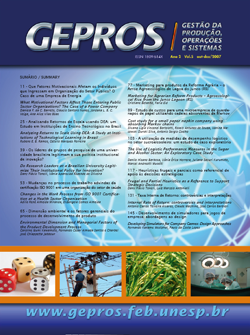Developing Simulators for Company Games: Design Approaches
DOI:
https://doi.org/10.15675/gepros.v0i4.185Abstract
Faced with the visible growth of the use of company games in teaching production engineering and other professional formation areas, the absence of systematized references can become an obstacle to the development of new games and simulators. In this context, the present bibliographical study sought to introduce the key structural elements in developing simulators for company games. Thus, three approaches to simulator design (GOOSEN, 1981; TEACH, 1990; HALL, 2005) are analyzed in general terms, and where four structural elements for developing simulators are highlighted and treated in greater depth: (a) scenarios (GOOSEN, 1981); (b) decisions (KEYS; BIGGS, 1990); (c) algorithm modeling (GOLD; PRAY, 1983; GOOSEN, 1986; TEACH, 1990b; GOLD; PRAY, 2001); and (d) performance evaluation methods of participants in company games (ANDERSON; LAWTON, 1988, 1990). The set of studies summarized and analyzed herein can become an important reference source for new developers of simulators for company games and for those who study the area. Key words: Simulators; Company Games; Simulator Design.Downloads
Published
How to Cite
Issue
Section
License
O(s) autor(es) do artigo autorizam a publicação do texto na revista e garantem que a contribuição é original e inédita, não estando em processo de avaliação em outra(s) revista(s). As opiniões, ideias e conceitos emitidos nos textos são de inteira responsabilidade do(s) autor(es), não sendo a revista responsável por tais conteúdos.
Os editores da revista reservam o direito de efetuar ajustes textuais e de adequação às normas da publicação, caso necessário.
Os autores mantêm os direitos autorais sobre o trabalho e concedem à revista o direito de primeira publicação, sendo o trabalho simultaneamente licenciado sob a Attribution 4.0 International (CC BY 4.0), o que permite o compartilhamento do trabalho com reconhecimento da autoria e publicação inicial nesta revista.
Os autores têm autorização para firmar contratos adicionais, separadamente, para distribuição não-exclusiva da versão do trabalho publicada nesta revista (ex.: publicar em repositório institucional ou como capítulo de livro), com reconhecimento de autoria e publicação inicial nesta revista.












